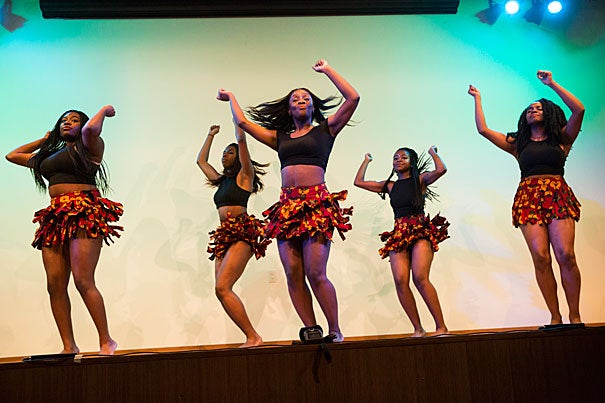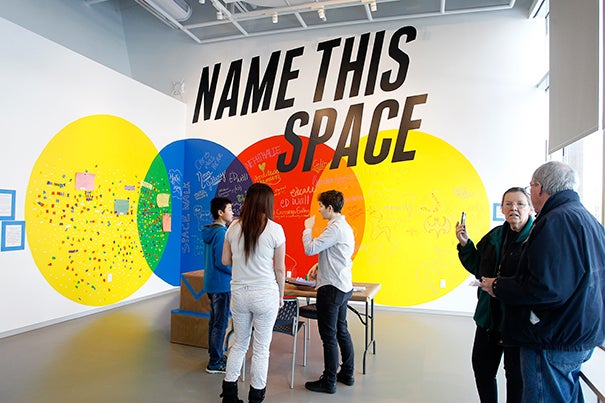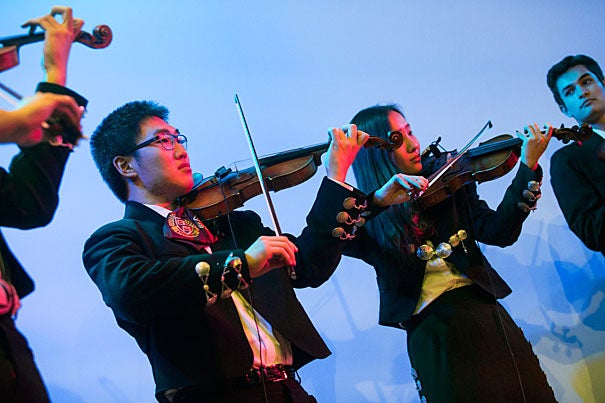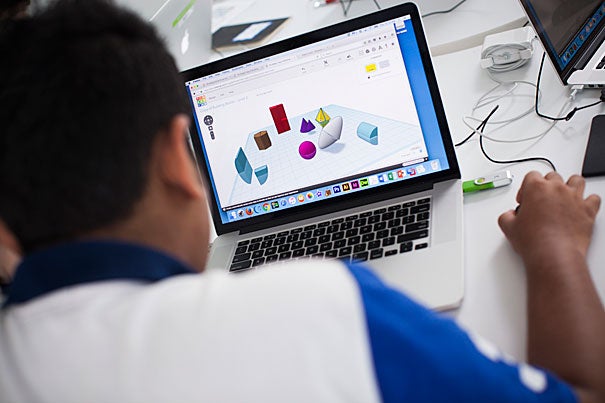
The Harvard Ed Portal has become a key player in the cultural renaissance in the Allston-Brighton community, where University students can give back, emerging artists can share their work, and local residents can discover new experiences.
File photo by Jon Chase/Harvard Staff Photographer
Creative momentum at the Ed Portal
Allston-Brighton welcomes programs in visual arts, ceramics, and more
The all-glass facade reflecting a busy block catches the eye at 224 Western Ave. in North Allston-Brighton. But the truly striking feature of the Harvard Ed Portal is the world of creativity, inspiration, and imagination generated by a special partnership between Harvard University and the Allston-Brighton community.
The Ed Portal was created in 2008 as a collaborative effort among Harvard University, the city of Boston, the Harvard Allston Task Force, and the Allston-Brighton community. The goal was to provide opportunities for creative paths to learning for people of all ages, backgrounds, and capabilities.
The Ed Portal works to open doors of opportunity in science, technology, wellness, recreation, professional development, and, most recently, arts and media. With a move to new space at Western Avenue in 2015, it greatly expanded its resources with the street-level Crossings Gallery, a 120-seat theater, classes, and resource rooms.
The gallery has become a dynamic destination where emerging artists build their knowledge and share their inspiration. It’s a place where children learn and students grow, where locals and visitors alike can find a flourishing farmers’ market, take in an art show, listen to panel discussions, participate in workshops, or learn to dance. Nearly all the programs are free.
Nate Dow of Brighton walked by the building many times before he was drawn in by the artwork in the window.
“I never realized Harvard was bringing arts and education to my neighborhood,” said Dow, a photographer whose first solo exhibition, “Lost in Boston,” is now on view at the Ed Portal. “It’s very, very good for the community.”
“One of the most powerful ways to bring people together is through the visual arts and performance,” said Robert Lue, faculty director of the Harvard Ed Portal, Richard L. Menschel Faculty Director of the Derek Bok Center for Teaching and Learning, faculty director of HarvardX, and a professor of the practice of molecular and cellular biology.

“Thus, we are excited by the growing breadth and depth of arts programming at the Harvard Ed Portal. Providing a venue for the abundant arts talents in Allston and Harvard — from performing artists to filmmakers to visual artists — to share and learn together is really what the Ed Portal is all about.”
Last September, the Crossings Gallery hosted an exhibition called “Changing Allston” that challenged local artists to reimagine the community with reflections from the past and visions for the future.
To local artist and musician Dave Tree, whose work in multimedia imagery was featured, the exhibition illustrated the value of the Ed Portal to the community. In a word, he said, it provides “opportunity.”
“They open the doors to people in the community who don’t go to Harvard but want to talk about their work, and give struggling artists the opportunity to flourish,” said Tree. “I met some really inspiring people who do really inspiring work.”
Lifelong Allston resident Anthony D’Isidoro, the board chair of the Allston-Brighton Community Development Corporation, said the Ed Portal is one of the best things Harvard has done for the community.
“This facility, the programs offered and what they are trying to accomplish, has a very positive effect on the community,” he said. “It’s a win-win.”
“The Harvard Ed Portal arts program aims to connect the Allston-Brighton and Greater Boston communities to Harvard’s resources in the arts, while also highlighting and amplifying this neighborhood’s incredible cultural assets,” said Eva Rosenberg, arts program manager at the Ed Portal. “In addition to increasing access to excellence in the arts, a common thread of our visual, performing, media, public, and teaching arts programs and events is supporting and helping develop the capacity of local individual artists and creatives.”
Among those programs: workshops focused on grant funding that bring in speakers from Ed Portal partners such as the Boston Foundation, New England Foundation for the Arts, the Mayor’s Office of Arts & Culture, Boston Creates, and the Mass Cultural Council.
“The Ed Portal helps us get individuals plugged into things around Boston for projects, shows grants, workshops, all sorts of opportunities,” said Kara Elliott-Ortega, director of planning and policy for the Mayor’s Office of Arts and Culture. “It’s very grassroots, open to the public, and a way for people to connect in their neighborhood and a network.”
In addition to the Ed Portal’s collaborative resources, the Harvard-Allston Partnership Fund (HAPF) awards $100,000 in annual grants to local organizations, with some of the funds supporting cultural enrichment and community enhancement. Since its inception in 2008, HAPF has provided $800,000 to 25 local organizations, boosting programs for more than 4,300 residents.
The Ceramics Program, Office for the Arts at Harvard, has been part of the Allston-Brighton neighborhood for 35 years, and next to the Ed Portal for two. The program hosts classes, lectures, and exhibitions in the street-level Gallery 224. As neighbors, the Ceramics Program and the Ed Portal often partner on programs such as art-making workshops for youth, joint exhibitions in the adjacent galleries, and a new ceramics scholarship aimed at increasing studio access for Allston-Brighton residents.
“We are a unique part of Harvard because we serve both the Allston-Brighton and Harvard communities,” said Kathy King, director of education with the Ceramics Program. “Any class you take here you could be sitting next to a professor, a student, or a neighbor. It’s such a great mix.”
The Sculptor’s Workshop, a collaboration of 10 artists working in a small studio on Franklin Street in north Allston-Brighton, recently organized the exhibition “Made in Allston: The Sculptor’s Workshop” at both Crossings Gallery and Gallery 224.
“The collaborative exhibitions are very inspirational to see — how the art tells a story, the meaning of the words, colors, the aesthetic; it’s accessible and inclusive,” said Salvador Jiménez, Ceramics Program artist in residence.
Reylon Yount ’16 thinks community accessibility and inclusion are paramount for student artists, and worked with the Ed Portal to launch the Cultural Connections performance series. The program, inspired by the Harvard Foundation’s annual Cultural Rhythms show, features performances of different genres and styles by College students from diverse ethnic and cultural backgrounds.
“The Ed Portal is an incredible venue and opportunity,” Yount said. “I think it’s a catalyst because the community is there, as is the desire for students to broaden their experience beyond campus. The Ed Portal is a perfect intersection where those two communities can meet.”
Yount works with Silkroad, which was established by Yo-Yo Ma to explore how the arts can advance greater cultural understanding.
Silkroad, the nonprofit that supports the touring and educational work of the Silk Road Ensemble, has worked to bring the Grammy Award-winning excellence of ensemble musicians to Allston-Brighton.
“The Harvard Ed Portal provides a space that feels very comfortable and open to experimentation, which is often hard to find,” said Ben Mandelkern, Silkroad director of communications. “It’s an amazing opportunity to connect with people in the community, and some of the work we have done there has rippled out to our other work around the world.”

For artist Lindsey Kocur, the Ed Portal is helping turn creative ideas into reality by connecting her work to a broad audience. Her mixed-media project “Free Space” most recently appeared as part of the Crossings Gallery’s “Changing Allston” exhibition and now is being transformed into a large-scale sculpture for display in front of the Ed Portal this spring.
“My experiences with the Harvard Ed Portal have allowed me to witness the many ways they strive to bring art and the community together, promoting thoughtful dialogue and active participation,” Kocur said.
These are just a few of the happenings in North Allston-Brighton helping to deepen a long tradition of resident artists and creative energy.
“This whole neighborhood is really starting to boom,” said Dow. “It’s amazing when you look around and see all the quality things going on here now. Anything that helps connect the community and foster the arts is so important. I’m all for it.”





